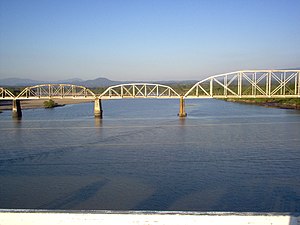Lempa River
| Lempa River | |
|---|---|
 Sunset over the Lempa river | |
 Railroad Bridge (FENADESAL) over the Lempa river, as seen from the Carretera del Litoral highway bridge (El Salvador) | |
| Location | |
| Countries | |
| Physical characteristics | |
| Source | Sierra Madre |
| • location | Olopa, Chiquimula, Guatemala |
| • coordinates | 14°41′33″N 89°18′18″W / 14.69250°N 89.30500°W |
| • elevation | 1,200 m (3,900 ft) |
| Mouth | Pacific Ocean |
• location | El Playón, Tecoluca, San Vicente, El Salvador |
• coordinates | 13°15′17″N 88°49′38″W / 13.25472°N 88.82722°W |
• elevation | 0 m (0 ft) |
| Length | 422 km (262 mi) |
| Basin size | 18,246 km2 (7,045 sq mi) |
| Discharge | |
| • location | Cuscatlan bridge[1] |
| • average | 362 m3/s (12,800 cu ft/s) |
The Lempa River (Spanish: Río Lempa) is a 422-kilometre-long (262 mi) river in Central America.[2] It is a transboundary river shared by El Salvador, Guatemala and Honduras.[3]
Geography
[edit]Its sources are located in between the Sierra Madre and the Sierra del Merendón mountain ranges in southern Guatemala, near the town of Olopa.[2] In Guatemala, the river is called Olopa River and flows southwards for 30.4 kilometres (18.9 mi) before entering Honduras and changing its name to Lempa River at 14°32′52″N 89°15′50″W / 14.547700°N 89.264002°W. In Honduras, it flows through the Ocotepeque Department for 31.4 kilometres (19.5 mi), and crosses the border with El Salvador at the town of Citalá (14°22′19″N 89°12′45″W / 14.371857°N 89.212439°W) in the Chalatenango Department. The river continues its course for another 360 kilometres (220 mi) in El Salvador, flowing in a generally southwards direction until it reaches the Pacific Ocean in the San Vicente Department.[2][4] The river forms a small part of the international boundary between El Salvador and Honduras.
The river's watershed covers 18,246 km2 (7,045 sq ml) of which 10,255 km2 (3,959 sq ml), that is, 56.56% of the watershed territory, lie in El Salvador; 5,696 km2 (2,199 sq ml) in Honduras; and 2,295 km2 (886 sq ml) in Guatemala.[1] 49% of El Salvador's territory is covered by the Lempa River basin,[1] and 77.5% of the Salvadoran population lives in cities, towns, and villages located within the basin territory, including the capital city of San Salvador.[4]
Hydroelectricity
[edit]
There are several hydroelectric dams along the river. In El Salvador, there is the Guayojo Dam, the Cerrón Grande Hydroelectric Dam, the 5 de Noviembre Dam, and the 15 de Septiembre Dam. The latter can be easily seen from the Pan-American highway.
See also
[edit]- List of rivers of Guatemala
- List of rivers of Honduras
- List of rivers of El Salvador
- List of rivers of the Americas by coastline
References
[edit]- ^ a b c "Water Resources Assessment of El Salvador" (PDF). United States Army Corps of Engineers (USACE). 1998. Archived from the original (pdf) on 2009-01-09. Retrieved 2009-05-04.
- ^ a b c Hernández, Walter (2005). "Nacimiento y Desarrollo del río Lempa" (pdf). San Salvador: Servicio Nacional de Estudios Territoriales (SNET). Retrieved 2009-05-03.
- ^ Montoya, Ainhoa (2024). "Troubling environmental governance: citizen legal experiments with transboundary commons". Oxford Development Studies. 52 (4): 396–412. doi:10.1080/13600818.2024.2395008.
- ^ a b "Mapas de Recursos Hídricos". San Salvador: Servicio Nacional de Estudios Territoriales (SNET). Archived from the original on April 22, 2009. Retrieved 2009-05-03.


 French
French Deutsch
Deutsch